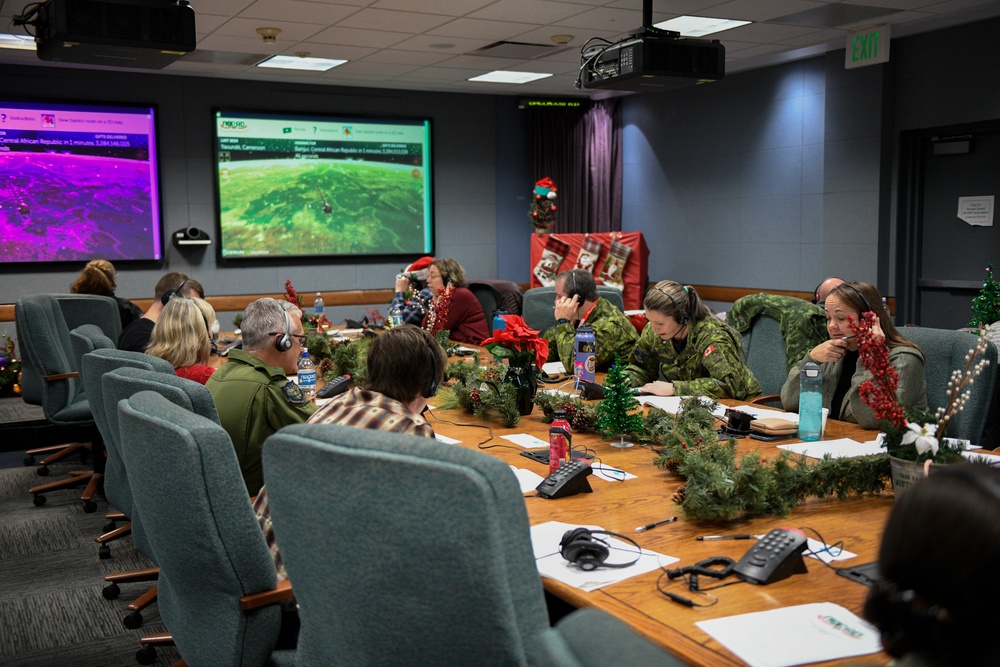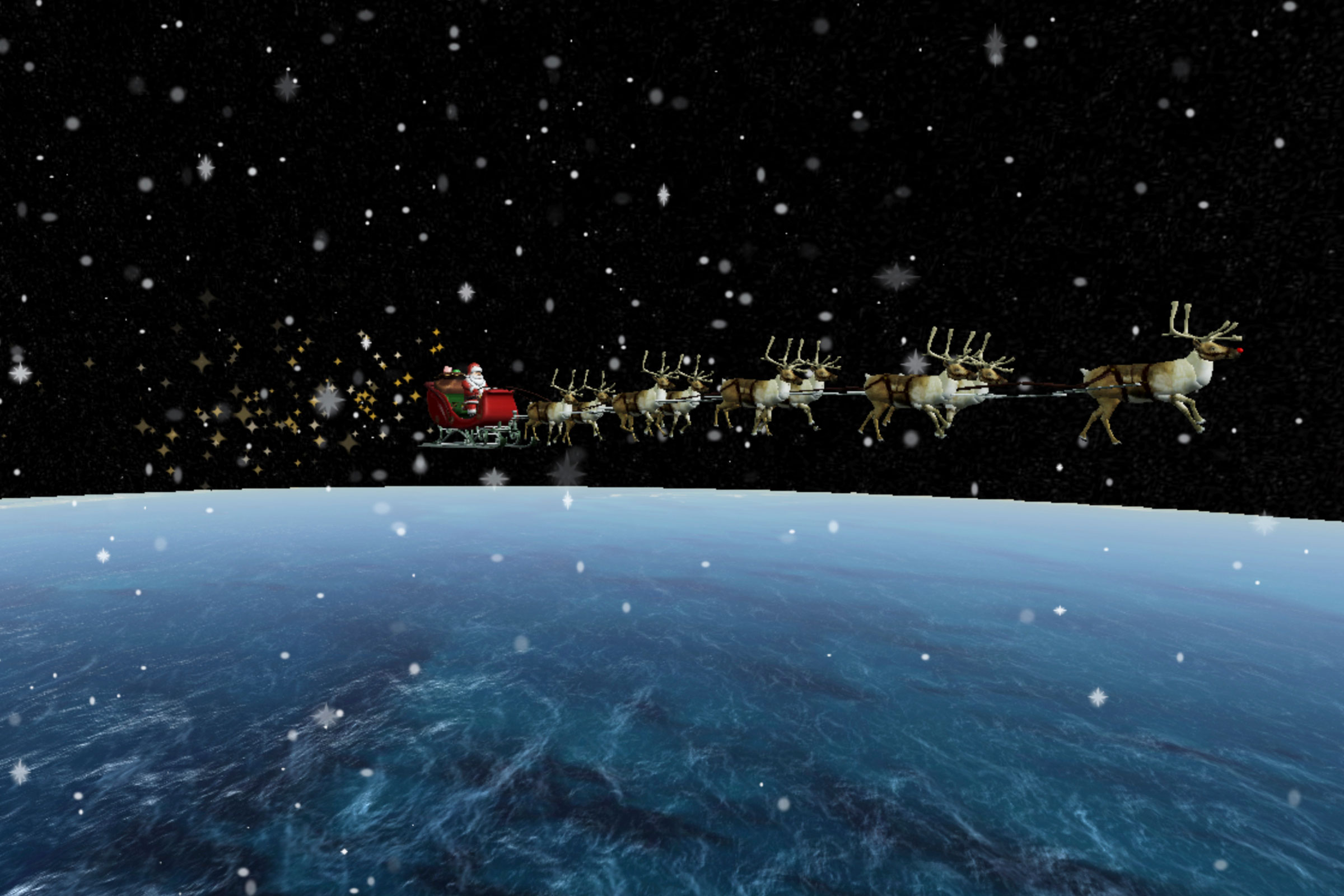
Millions of Americans go to sleep full of anticipation on Christmas Eve. But for workers at the North American Aerospace Defense Command (NORAD), Dec. 23 is their final night before a busy and riveting day.
NORAD and U.S. Northern Command Public Affairs director Col. Elizabeth Mathias and more than 1,200 volunteers—mostly U.S. and Canadian military personnel and local community members in Colorado Springs—spend Dec. 24 working on the NORAD Tracks Santa program. The website that allows users to follow Santa's sleigh has become a phenomenon, garnering 9.6 million page visits in 2022.
"Three-hundred sixty-five days a year, NORAD is keeping an eye on things that could potentially threaten North America, and making sure that the nation's leaders in both the U.S. and Canada are aware and can take appropriate action if necessary," Mathias told TIME in a phone interview on Dec. 12. "But on Dec. 24, we have one additional very special mission, which is to track Santa as he flies around the globe and ensure his safety of flight. We do that with the same systems NORAD uses every day."
TIME spoke to Mathias about the NORAD Santa Tracker’s origins, the surprisingly huge effort behind the program, and getting a call from members of the Ukrainian military last Christmas Eve.
The following interview has been lightly edited and condensed for clarity.

How long have you been working with the Santa tracker program?
This is my second Santa tracking season. It was a real delight to find out that this was one of my responsibilities when I joined the team here in 2022. But the NORAD Tracks Santa program has been happening for 68 years.
How exactly did the program get started?
The origin story has a few twists and turns, but the story that we all understand is that a local store had published an advertisement that had a number for children to call and speak with Santa at the North Pole. A child called that number, but misdialed it, and instead reached an unpublished number to the military operations center for the organization that at the time was called the Continental Air Defense Command. This was in 1955. The Air Force colonel who answered the phone that day, and was speaking to a child asking to talk to Santa Claus, started to play along and realized that there might be more children calling and the ops center should be prepared for it. We carry that tradition forward each year by having an ops center that answers phone calls, as well as allows fans to track Santa on the website.
Can you share how the program runs and operates?
I think about the NORAD Tracks Santa program all year long. I have two personnel who are responsible with keeping things on track throughout the year. And when we're looking at NORAD Tracks Santa in February, or in May, or in September, we're doing a couple key things. One is maintaining relationships with our more than 70 contributors who are outside entities. Those are some of our key partners, like Microsoft or Amazon Web Services, or Cesium or Ansys. We also have some of our more local contributors like our Colorado Springs Military Affairs Committee or the Air Force Academy Band.
We also are working very closely with the base community here at Peterson Space Force Base in Colorado Springs. They provide us with the facility for our call center and support for our communications lines. We also are starting to think about what our volunteer footprint would look like. We have more than 1,200 people volunteering every Dec. 24 to help us not only run the call center but answer those phone calls from around the world. In 2022, we received more than 260,000 phone calls on Dec. 24.
Once we get into the holiday season, we're really thinking about how to let people know that they can join us again this year to track Santa. So we have a lot of social media content available on several platforms. We conduct outreach to reporters around the world in several languages. We launched our website every Dec. 1 so that by the time we get about the middle of December, people are starting to get excited.
On Dec. 20, we make the call center sort of operational; we decorate, we have our contributors come in and help us set up, but we don't start answering phone calls. We don't start tracking Santa until he takes off for his annual journey on Dec. 24. And once he starts flying, we help everybody know that he's on his way so that they can plan their celebrations and most importantly, be in bed before he arrives.
I'm wondering if you can really walk me through what Dec. 24 looks like for you, because I imagine it's a hectic 24 hours.
It absolutely is. We start with our space-based systems, our satellites, that are able to detect Rudolph's red nose when Santa takes off from the North Pole. And then we're able to use our radar systems and satellites around the world to know where he is. And then when he gets closer to North America, we're able to use our NORAD aircraft, our fighter jets, to actually visually detect Santa as he comes to the American continent.
So early on Dec. 24, when our call center goes live and our website goes live, is when Santa takes off. He doesn't file a flight plan with NORAD, but our fans around the world are welcome to call us at 1-877-Hi-NORAD (1-877-446-6723), or they're welcome to go to our website, www.noradsanta.org, and ask us to see where Santa is traveling.
We receive calls constantly throughout the day. We have really great conversations with people from around the world. We spend a lot of time talking to weather channels because a lot of their content on Dec. 24 is tracking the weather and whether Santa's flight could be interrupted.
Can you share a particularly silly or interesting phone call that you've received?
Last year, we received a phone call from members of the Ukrainian military, who just wanted to talk to somebody about being in the fight on Dec. 24, and one of our members of leadership here was able to talk to them and let them know that we were thinking about them. That was a pretty special moment and pretty emotional for the leader who took that phone call.
I personally took a phone call from a child in Amsterdam who was very excited to know when Santa would be there. And I explained that based on what we were seeing, he was going to be there within an hour and that they might want to get to bed. And this child responded, “Okay, I will tell them,” and literally ran away and didn't even hang up the phone.
What impact working on this team and project has on you and what has it taught you about the meaning of the Christmas spirit?
I would offer three things. I think one is that this program is a reminder of how meaningful it can be to contribute to something bigger than yourself. I don't see myself as managing this program or running this program so much as being a steward of this program because this program is way older than me.
I would additionally offer that it's a great reminder as a leader that everybody who participates in this program is able to learn from it. We have the opportunity to study it to look at, for example, the data of how many people visit our website or interact with social media posts. We can look at how we prepare some of our senior officials for media interviews.
The final thing I would offer is that anytime you talk to any person around the world and say that you're affiliated with NORAD, most of them will ask about NORAD Tracks Santa. And I see that as a reminder that sometimes what people think about the military, or what they're familiar with, may not be the thing that the military thinks or that may have been most recently on their mind. It's a reminder to zoom out and take a minute to appreciate the experiences that converge at this time of year across holiday traditions. And what people remember or cherish or bring into their traditions can always surprise you a little bit, in a way that reminds us all that we're connected through our holiday traditions.
More Must-Reads From TIME
- The 100 Most Influential People of 2024
- How Far Trump Would Go
- Why Maternity Care Is Underpaid
- Scenes From Pro-Palestinian Encampments Across U.S. Universities
- Saving Seconds Is Better Than Hours
- Why Your Breakfast Should Start with a Vegetable
- Welcome to the Golden Age of Ryan Gosling
- Want Weekly Recs on What to Watch, Read, and More? Sign Up for Worth Your Time
Contact us at letters@time.com